Chelsea have roped in Timo Werner from RB Leipzig and Die Rotten Bullen needed a replacement for the prolific striker. The beauty of the Red Bull group is that one can benefit from the other’s superior scouting. Since 2015, ten players have made a direct switch from RB Salzburg to RB Leipzig and Hwang Hee-chan has become the 11th in that list.
Speaking to Goal.com, Julian Nagelsmann expressed when asked about replacing Werner, “It’s not possible [to replace him], you can’t clone a player. If Timo Werner leaves us, the main thing would be to replace 34 goals a season.”
In this tactical analysis in the form of recruitment analysis, we will analyse if Hwang is the sole character to replace the 34 goals of Werner and observe how different is the South Korean’s playing style to the German or if both the strikers exhibit a similar set of characteristics.
Player overview
Hwang Hee-chan has been enormous for Salzburg last season and even under Marco Rose in 2017/18, where he was partnered alongside another striker, racking up 16 and 14 goals respectively. In 2018/19, he was loaned out to Hamburg where he struggled in the right-wing and as a lone striker.
With all being said, it indicates Hwang’s willingness to operate with a partner up front. The transition should be smooth if just going by the formation and philosophy of both the Red Bull clubs since both the clubs operate with two men upfront and believes in vertical passing.


Looking at the formation trends of both the teams, it looks like Leipzig like one of its strikers to play behind the other one, or the German club like one of its striker to operate in the hole or between the lines. Whereas the Austrian club likes both of its strikers to operate in the same line. Further into the analysis, we will determine how both the clubs use their strikers and whether Hwang fits into Nagelsmann’s tactics.
Off the ball movement in the final third
Hwang is a very intelligent forward who likes to operate in the half space between a centre-back and a full-back. In Salzburg, he has been mostly used on the left side of the front two. He would position himself in between the right centre-back (RCB) and right-back (RB) and would time his run looking for a through ball from his teammates.

This can be seen in the screenshot above against Hartberg. He positions himself in between the RCB and RB and times his run perfectly for a through ball/lob through. The diagonal body orientation he generates while making these runs is the key to the timing. It helps him to time his run perfectly while looking at the ball, thus gaining a slight advantage over the defender, since his body orientation is already towards the movement of the ball and it helps to prevent being offside as well. Occasionally you will find players, especially those who do not make such runs on a regular basis, to have either complete frontal body orientation or sideways.
He is a striker who doesn’t make much movement while in the final third. He waits for the defenders to make space for him. In other words, when Salzburg are in position, the opposition defenders move with respect to the ball to stay compact. This movement often generates space between the two defenders or between the two lines for a fraction of second. Hwang tends to use that fraction of seconds to his advantage by either making a well-timed run for a through ball in between the defenders, or makes himself available for a pass by occupying the space generated in between the lines by the movements of the opposition midfielders and defenders.

Here, Hwang sits in the half space but in between the two centre-backs. Dominik Szoboszlai (LW) makes a run between the RB and RCB. An opposition midfielder follows him and Szoboszlai’s movement also creates more height as well as draws the RCB’s attention. Hwang doesn’t stay in the same line with the defensive line anymore due to the movement of the opposition players. He realises the space generated for him and creates a passing option for his left-back. However, the LB passes the ball to Szoboszlai.
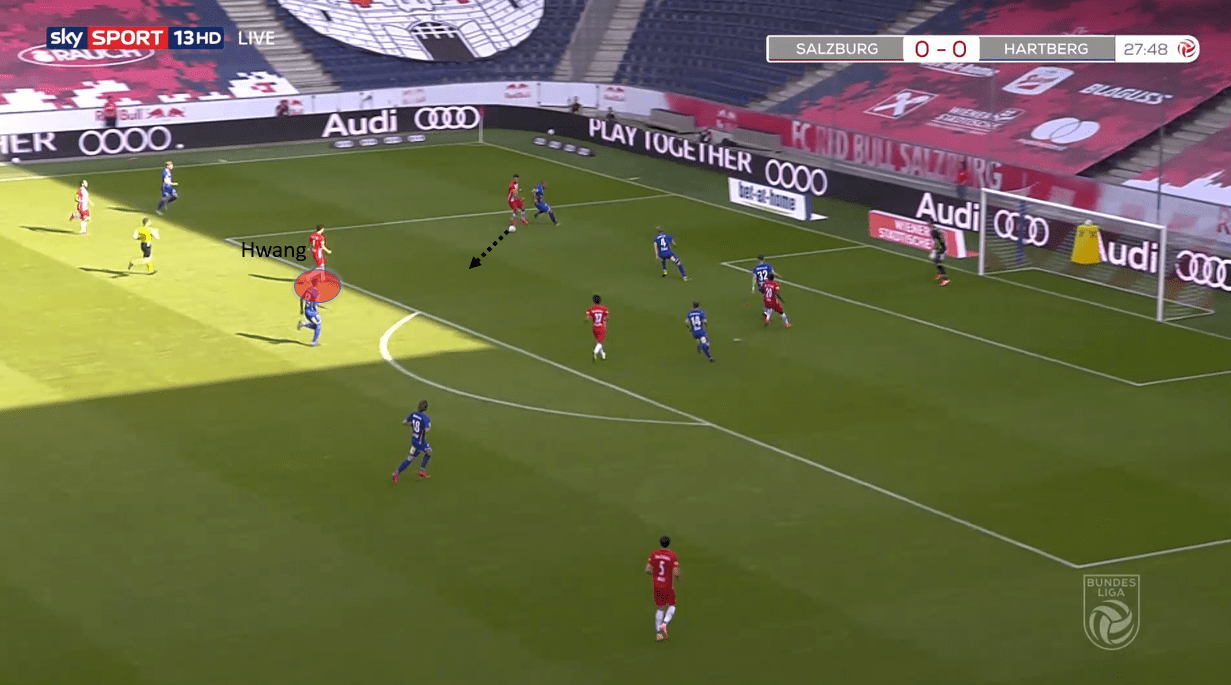
Since the opposition midfielder has followed Szoboszlai, it has generated a huge space in between the lines at the edge of the 18-yard box. Any pass to him by the Hungarian would have resulted in a shot by the South Korean.
The striker’s instinct
In the 18-yard box, the South Korean makes classic movements of a striker such as feints and ‘ghosting’ and amalgamates with the movements of the opposition defenders to create space for himself. This mixing of his movements often creates headaches for the defenders marking him.
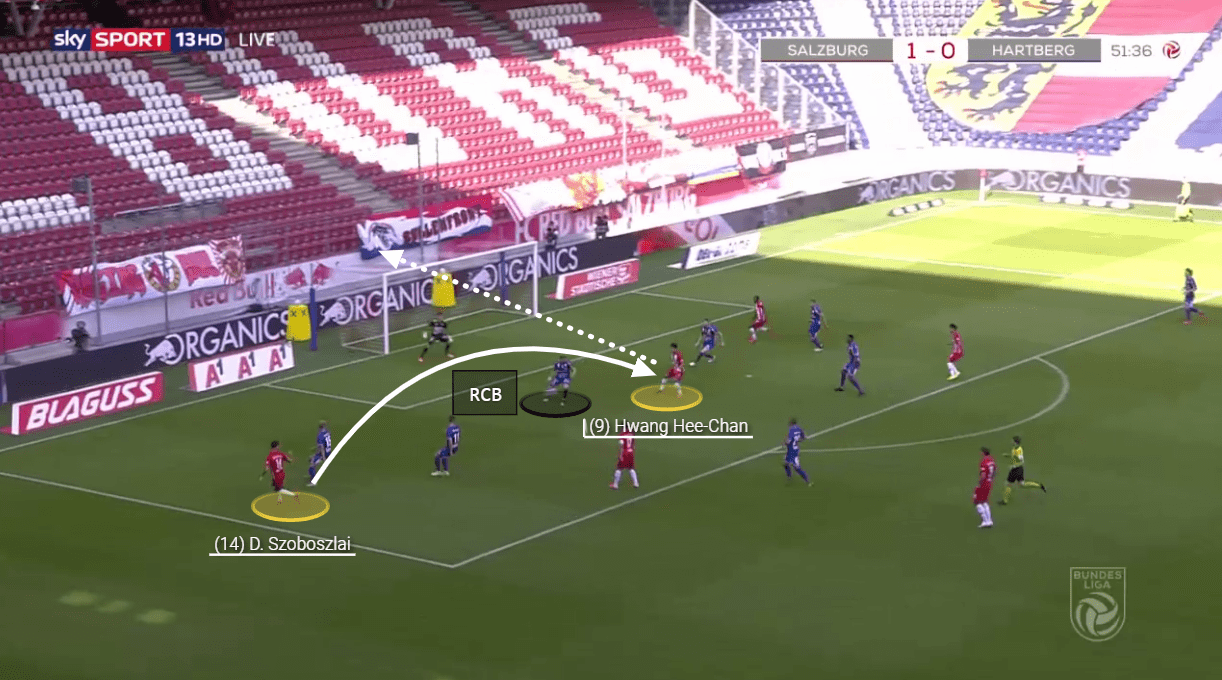
This screenshot is a classic example of the defenders creating space for the South Korean. Szoboszlai’s movement with the ball draws the RCB’s attention, so he makes a little movement towards the left-winger. The LCB of Hartberg doesn’t move left due to Patson Daka’s (RCF) presence. It creates a huge space for Hwang just in front of the goal. The defenders also create a greater height due to the Hungarian’s movement. So, Hwang sits in his place without further movement and the Hungarian winger finds the Bull (Hwang) in the penalty spot. Though the shot was off target, it demonstrated how the South Korean uses the movement of his team to manipulate the defenders to create space for him without him making much movement.
However, inside the 18-yard box, most of the time he himself creates space for himself rather than the opposition defenders creating space for him. The image below demonstrates the classic striker’s movement you would occasionally see from Ronaldo or Icardi.
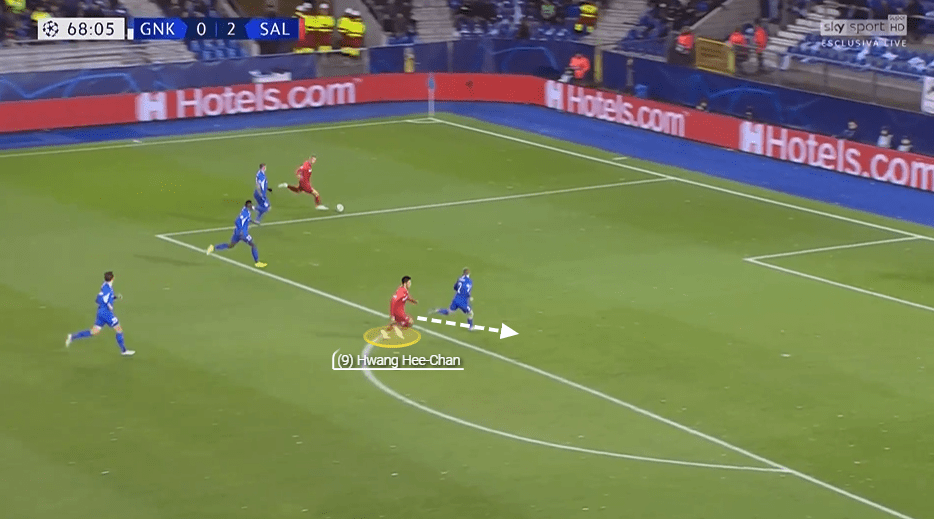
Hwang is very intelligent with his movements. He recognises the space in front of the #2 of Genk, however, if he positions himself directly in front of the #2, he would be a bit away from the near-post and thus his scoring chances would be lesser than if he is in front of the goal. He decides to opt for the ‘ghosting’ movement. He makes a movement towards the right thus dragging the defender towards himself to the right.
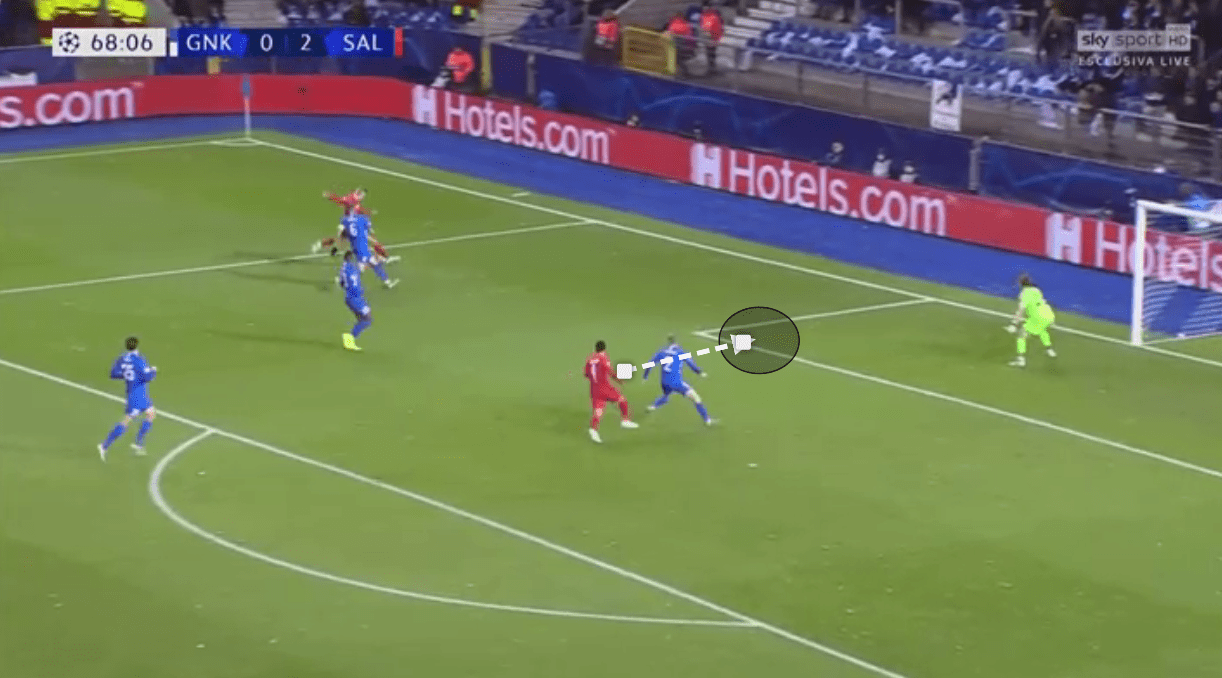
When he is able to drag the Genk defender towards himself, with a burst of intense, fast movement, he shakes off the defender and positions himself ahead of him.
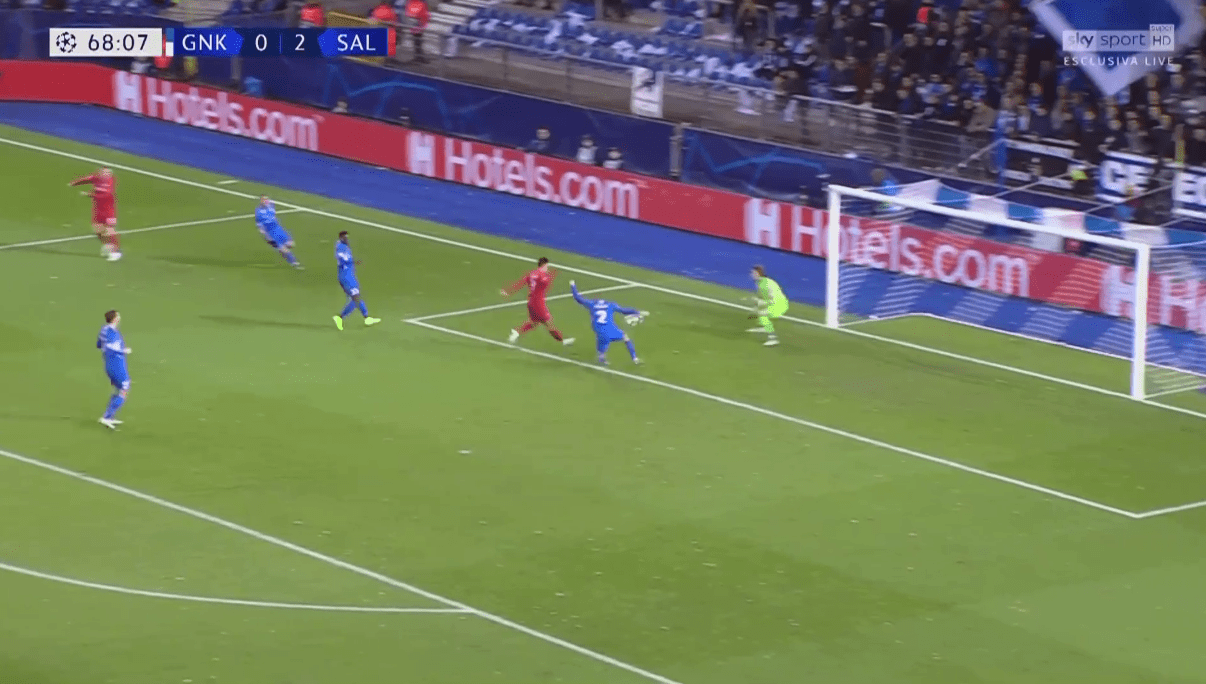
With Hwang, just in front of the goal and in a better scoring position, he needed just a good touch to slot it past the Genk goalkeeper. This sort of predator’s movement can be more often associated with Hwang than Werner.
Hwang is an intelligent footballer, who likes to get himself to a better scoring position. One of the reasons he has 66.20 % shot accuracy.
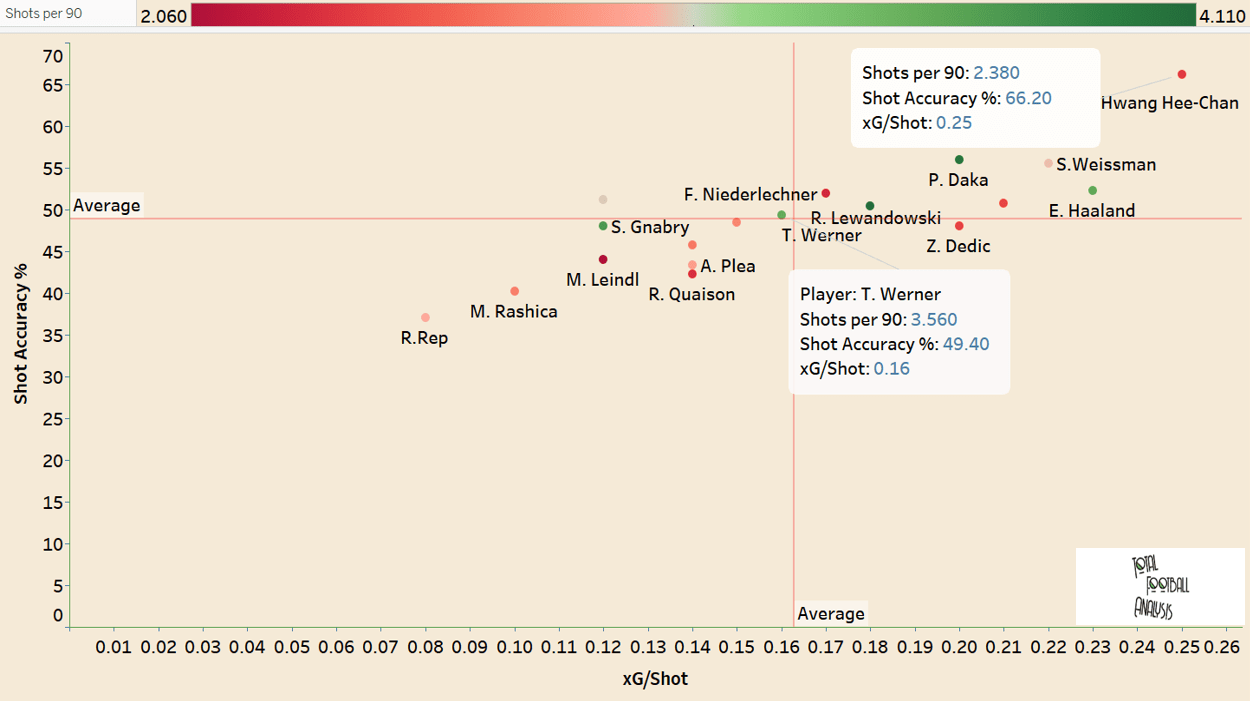
Comparing him with the players who have taken most number of shots in Bundesliga and Austrian Bundesliga and Erling Håland, he is much better in terms of both xG/shot and shot accuracy % by some distance. The South Korean always looks to find himself in a better scoring position in order to shoot. If he realises his teammate to be in a better position, he likes to lay off the ball for him to score. One of the reasons, he takes a lesser number of shots than most of the players in this category.
Hwang and Werner’s movement off the ball varies to an extent. The reason being Werner likes to operate in between the lines or position himself more towards the left flank. It results in Werner attacking the 18-yard box from a deeper area more often.
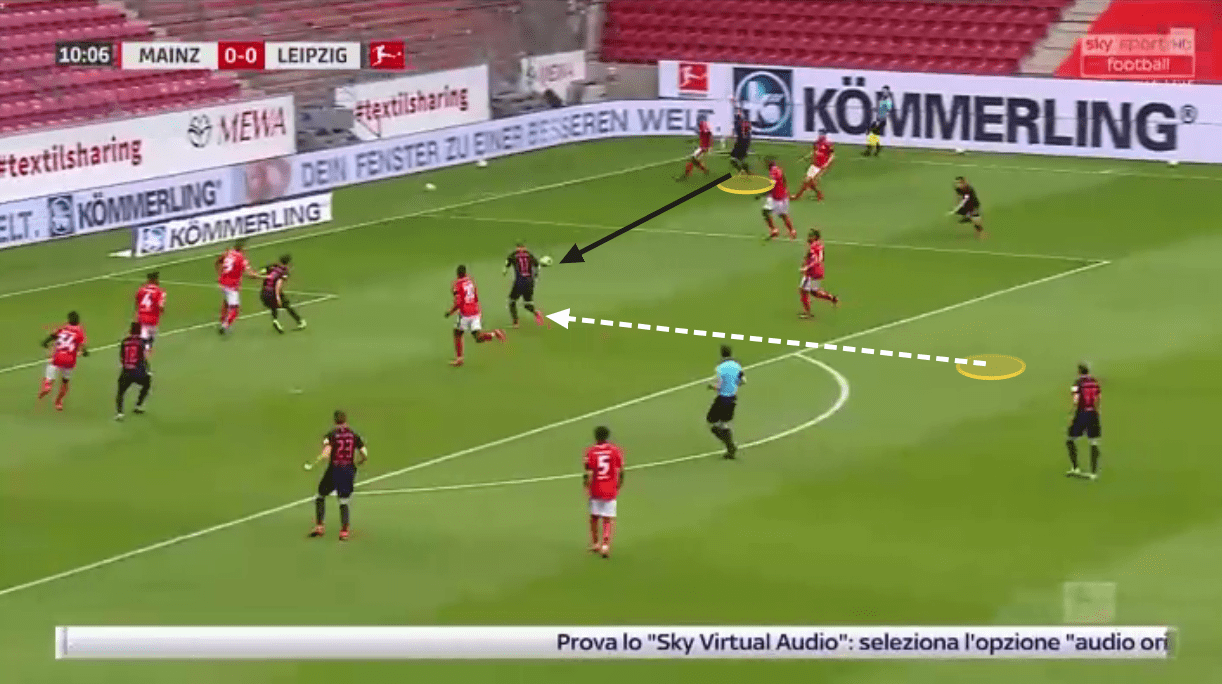
Here, Werner initially positioned himself in between the lines when the ball was played wide out to Konrad Laimer. Mainz midfielder, Edmilson Fernandes, looked to have done his job well positioning himself in front of the Mainz defenders. However, he failed to track the run of Werner who attacked the space in front of him and scored from Laimer’s cross. This sort of intelligent runs from deep of Werner occasionally results in a goal for Leipzig.
The shots map gives a vivid idea of the shooting positions of both the players.
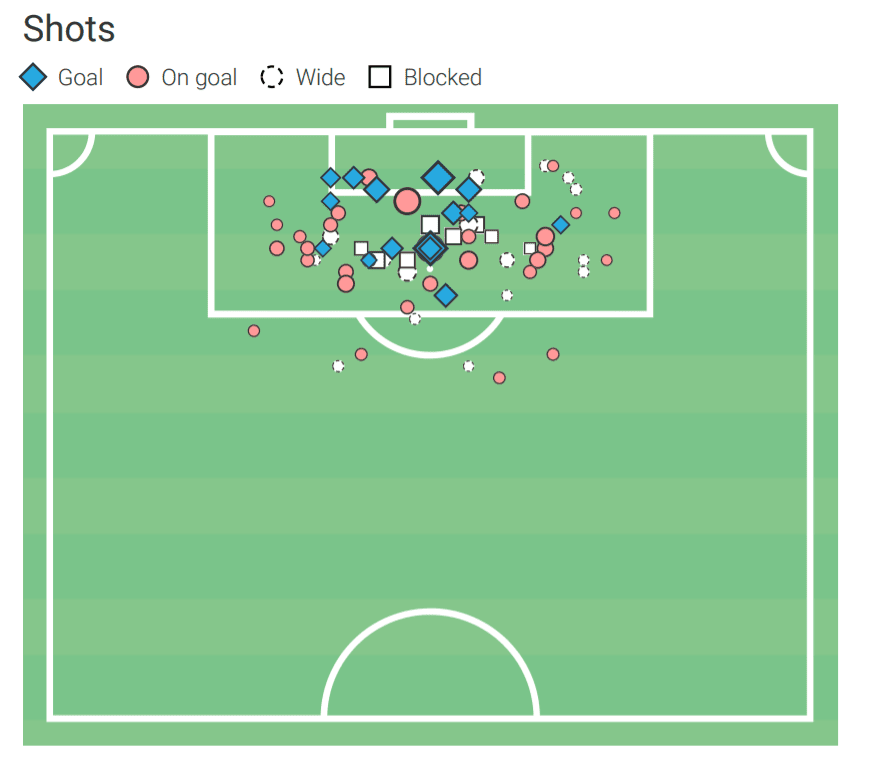
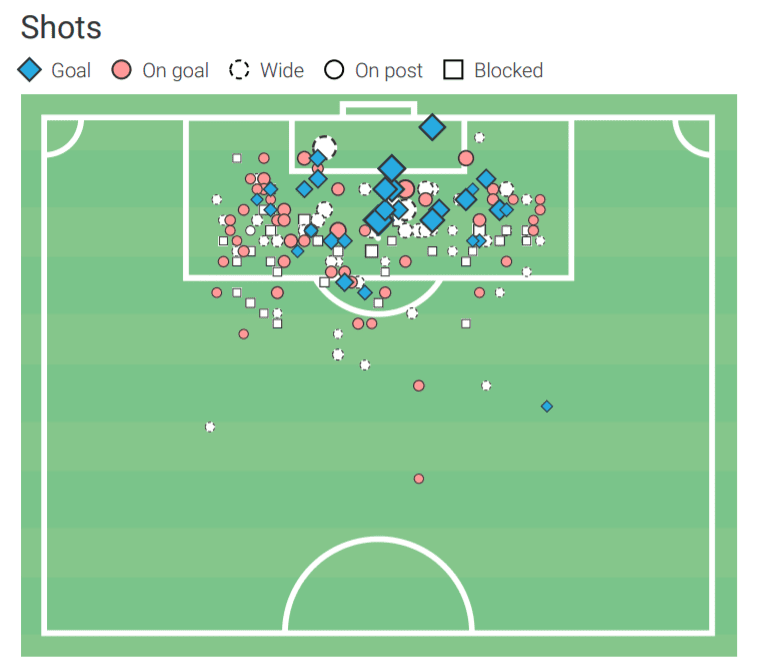
Apart from arriving late into the box, Werner likes to curl his shots from the left edge of the 18-yard box as well as occasionally shoots from outside of the box. Werner has taken almost 18% of his shots from outside the penalty area whereas Hwang has taken a mere 9.46% of shots from outside the penalty area. This validates the reason behind the South Korean striker generating a higher amount of xG/shot, with a better shot accuracy.
Attacking output
Hwang Hee-Chan with his intelligent movement and instant burst of acceleration often deceive the opposition. He is a master in getting himself to a better scoring position but occasionally lacks the final touch.
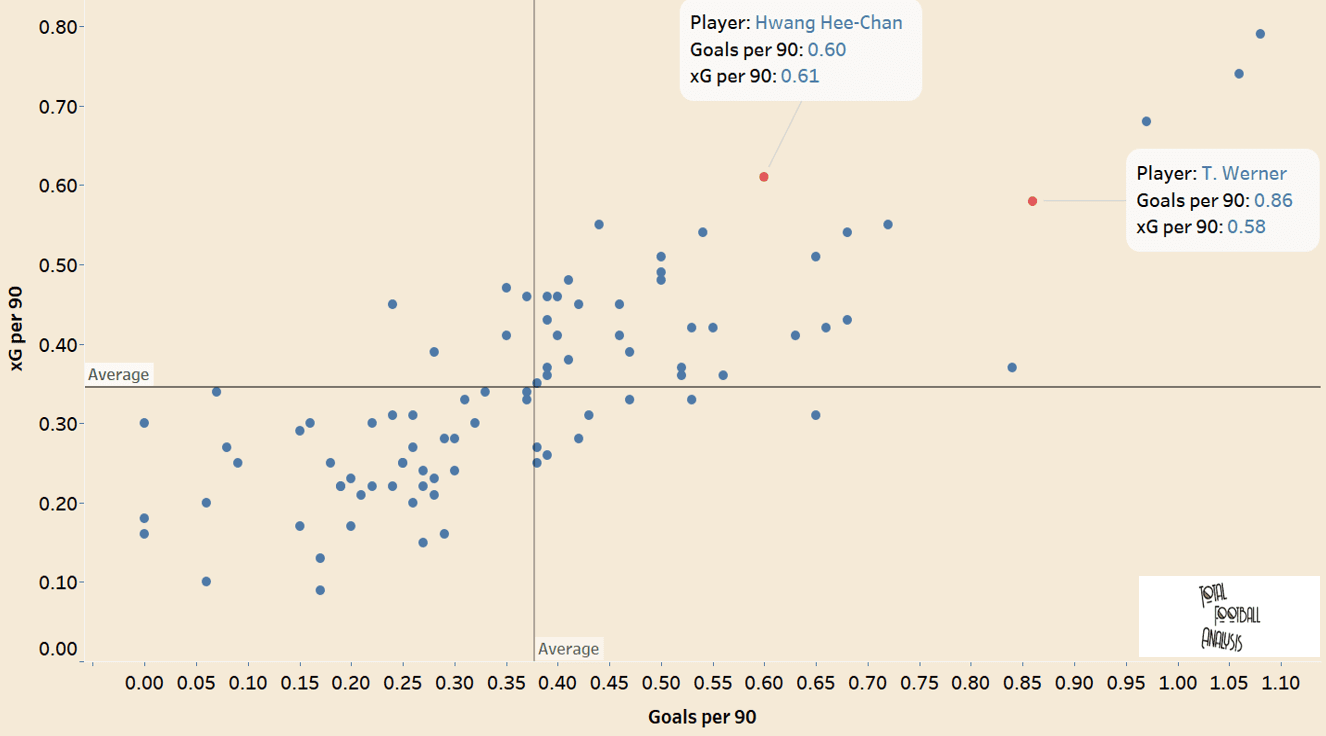
This graph, which considers strikers of Bundesliga and Austrian Bundesliga who had played more than 900 minutes, shows he had underperformed his xG by 0.01, which is minimal. However, going by the trend of his previous seasons, it looks like he does need a bit of more sharpness in his shooting. In 2018/19 he scored 0.12 goals per 90 with a xG of 0.18. In 2017/18 he had outperformed his xG by 0.11 (Goals: 0.45; xG: 0.34), in all competitions but if only the Austrian Bundesliga is considered he had underperformed his xG by 0.03 (Goals: 0.43; xG: 0.46) again.
It is not a big deal as he often finds himself in a better scoring position than most, but to reach the zenith he must sharpen his abilities in front of the goal. Even, Robert Lewandowski’s goal tally was in line with his xG for 2018/19. However, in 2019/20, he had outperformed his xG by a massive 0.32 (Goals: 1.06; xG: 0.74). Even his counterpart, Werner has outperformed his xG by 0.28 last season.
Apart from his clever movement inside and outside the 18-yard box, he often uses his different body orientations, strength, and dribbling ability to dribble past the opposition with ease. There is a preconceived notion that Asian footballers often lack the body strength to compete in a more competitive and physical league, but not anymore.
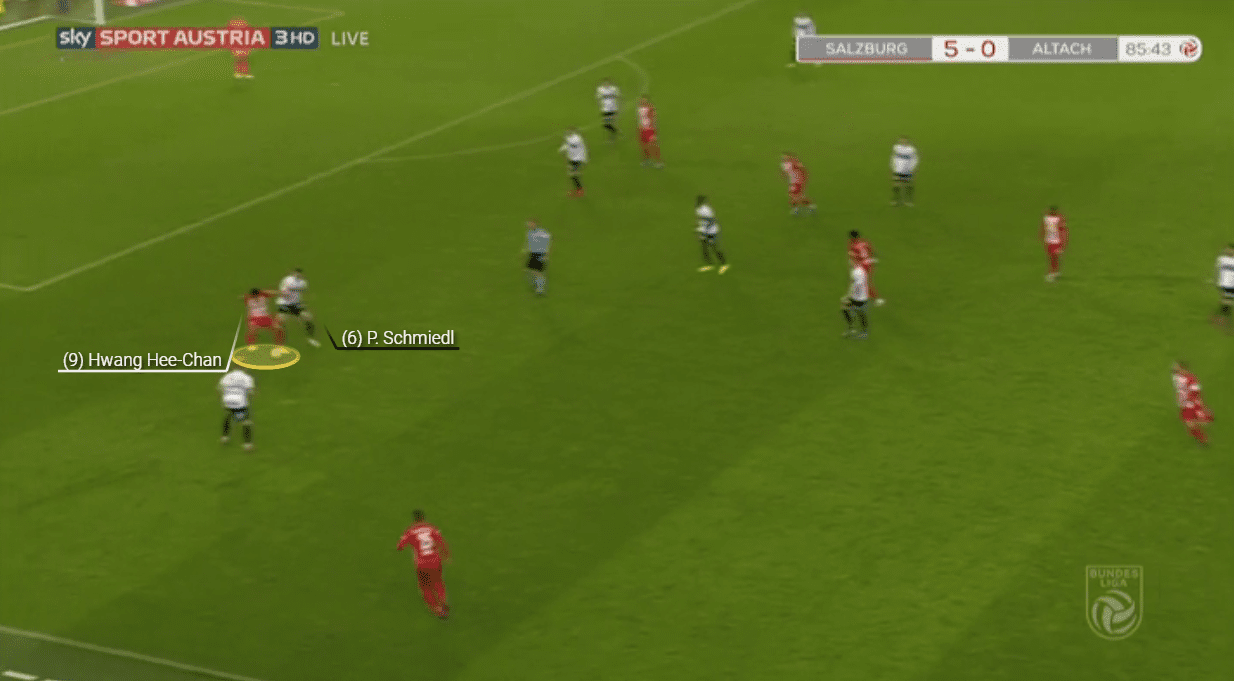
Here, Hwang initially positions himself back to his goal and draws Philipp Schmiedl towards himself. Once the ball is played to him and Schmiedl sticks to him, he manipulates his body using his strength to turn with the ball as well as block the defender.
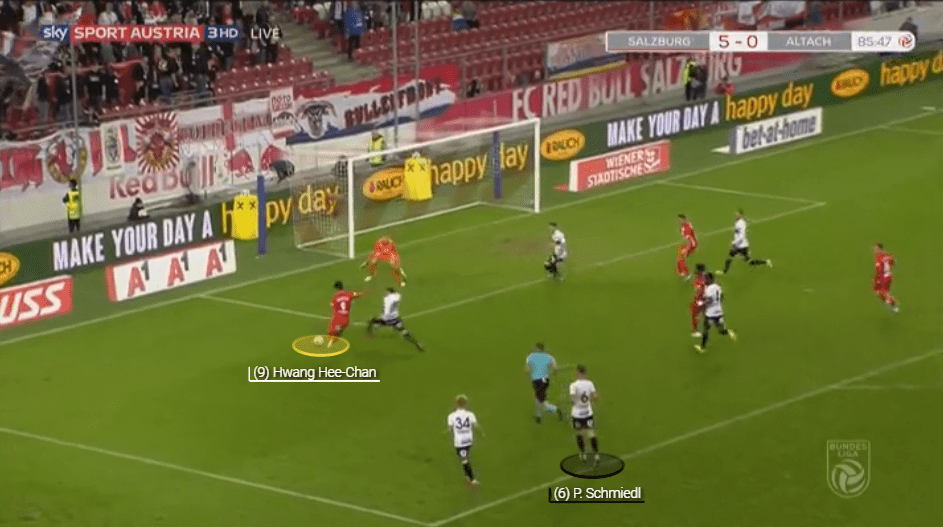
He easily beats the defender with the turn, carries the ball further, and blasts the ball past the goalkeeper with his left foot from such a tight angle. Here, Schmiedl (#6), who has been deceived by the strength and body manipulation of Hwang is seen lingering behind the South Korean.
This goal demonstrates Hwang does have the ability to finish from a tight angle thus overperforming his xG but occasionally misses a much easier chance.
The Hwang Special
Hwang Hee-Chan is an enormous dribbler and the number speaks for himself. He likes to position himself in line with the opposition defenders, manipulate his body to deceive the opposition defenders, dribble past them and score.
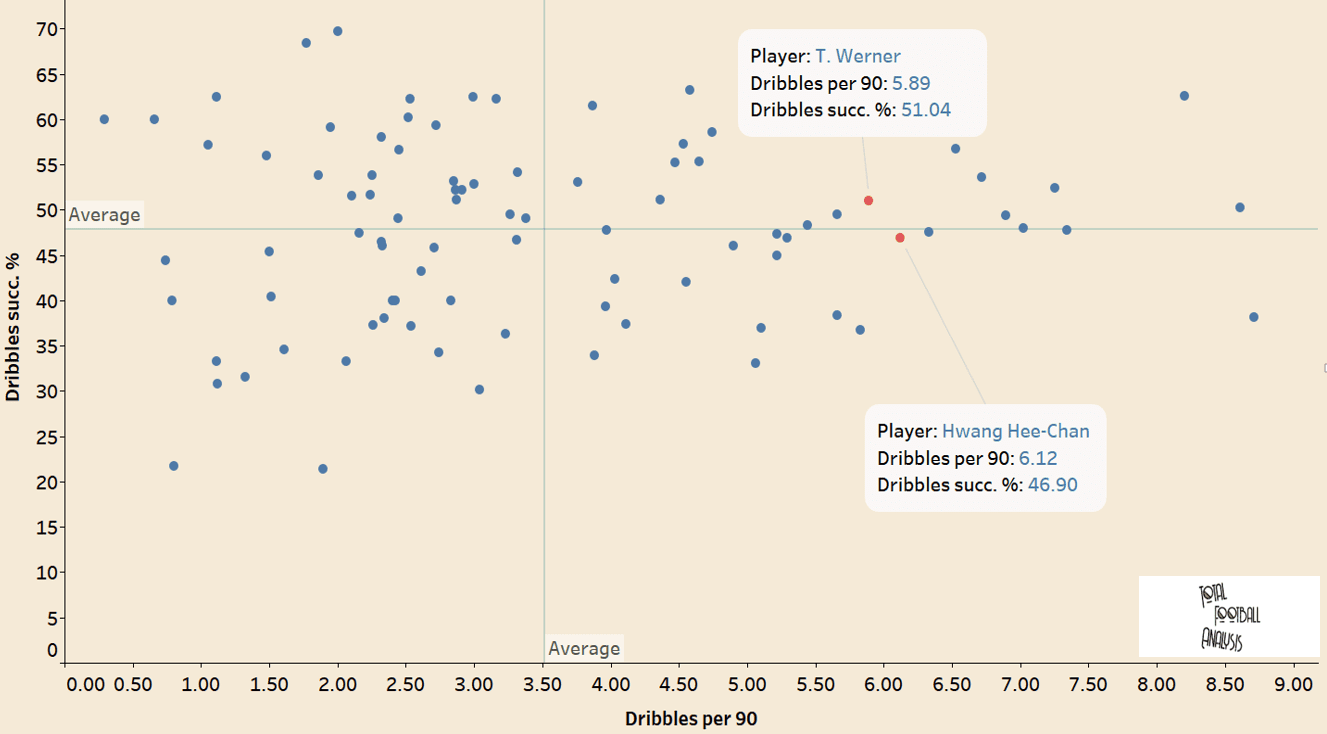
Being a striker, who mostly operates in the same line as opposition defenders, this number speaks volumes. He goes for 6.12 dribbles per 90 and wins 46.90 % of them. The numbers are almost similar to Timo Werner who operates in a deeper position than the South Korean.
‘The Hwang Special’ is the fake shot he attempts to deceive the last defender who is trying to make a last-ditch tackle on Hwang. The description might ring a bell and take you back to the fixture against Liverpool in UEFA Champions League. Yes, that’s the play Hwang does on a regular basis.
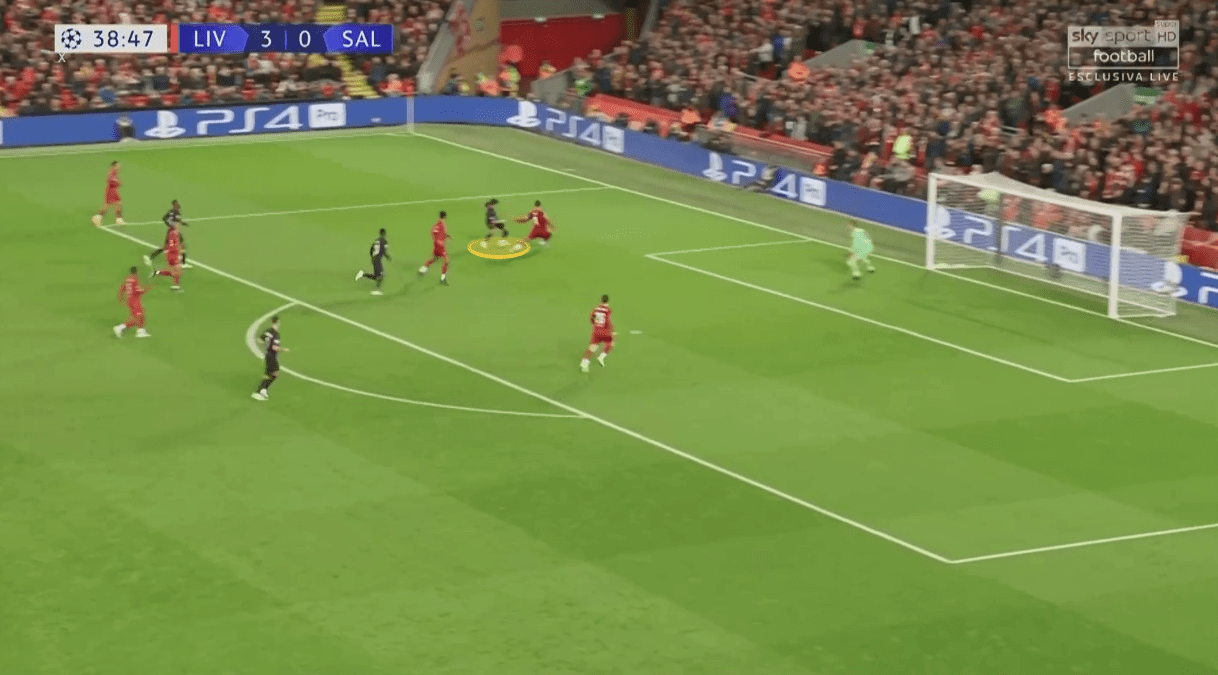
Here, Hwang receives the ball from Enock Mwepu at the edge of the 18-yard box, drives inside. He fakes a shot with his left foot and leaves Joe Gomez on the floor.
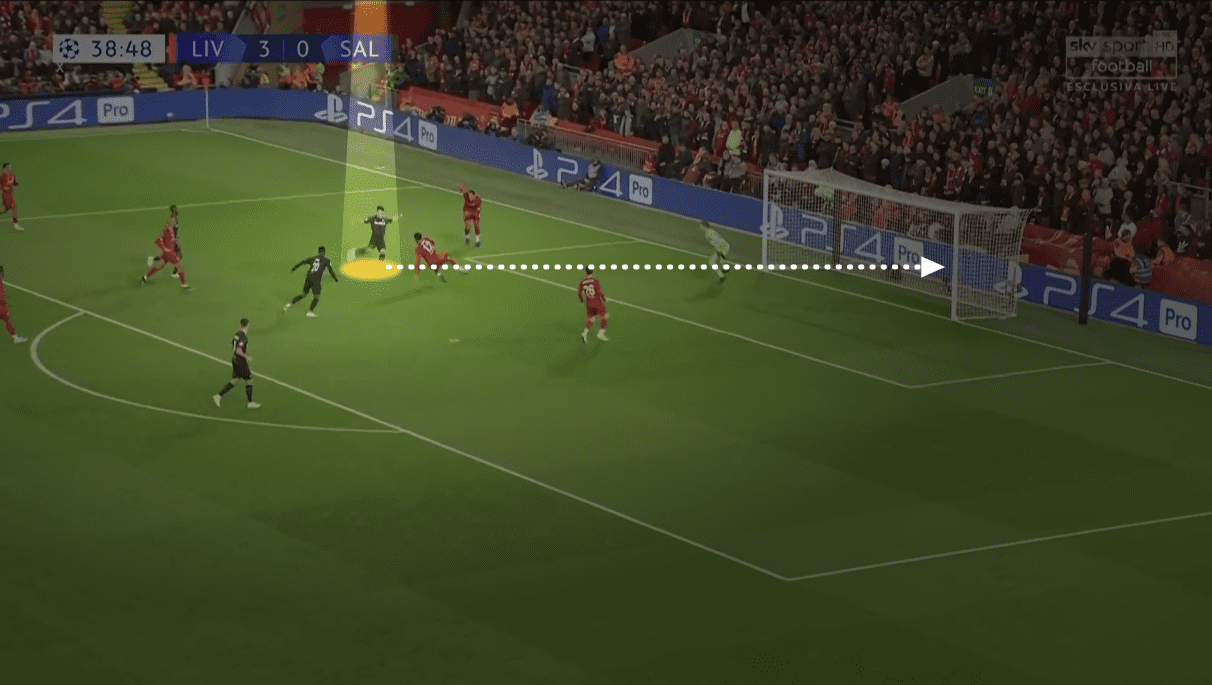
Once he was able to go past Gomez, he blasted the ball past Adrián to open the scoring for his team.
Once he fakes a defender, he gets himself to a better scoring position, thus increasing his xG. Other than the intelligent movements with which he creates a better scoring opportunity, his dribbling ability too, helps him immensely in this regard.
Link-up Play
Hwang Hee-chan, unlike Timo Werner, doesn’t involve himself much in the middle third i.e. drop deeper to create an overload in certain areas or open up a passing lane for his teammates. It has been reiterated multiple times in this analysis, however, the heat map would give a better explanation of the player’s presence in the most operated areas.
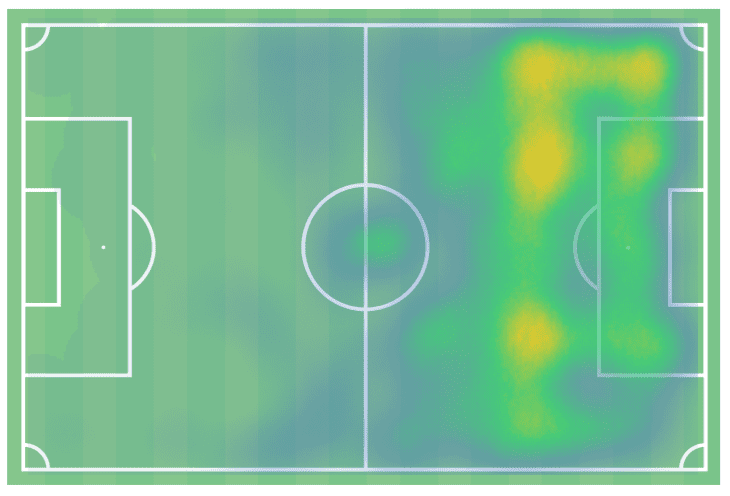

The heat map clearly indicates, Werner loves to drift out wide or drop a bit deeper to open up a passing lane. However, Jesse Marsch liked his star striker to be in line with the opposition defenders and link up in the final third where he is most dangerous apart from the 18-yard box.
Apart from the valiant dribbling skills he shows in the final third, he uses his body strength to a greater extent to lay off a pass to his teammates. The Red Bull clubs use vertical passing to a large extent, so it should not be much of a struggle for Hwang to transition from Salzburg to Leipzig. Vertical passing ensures he has a lot of bodies around him to lay off a pass or to go for the up-back-through passing.
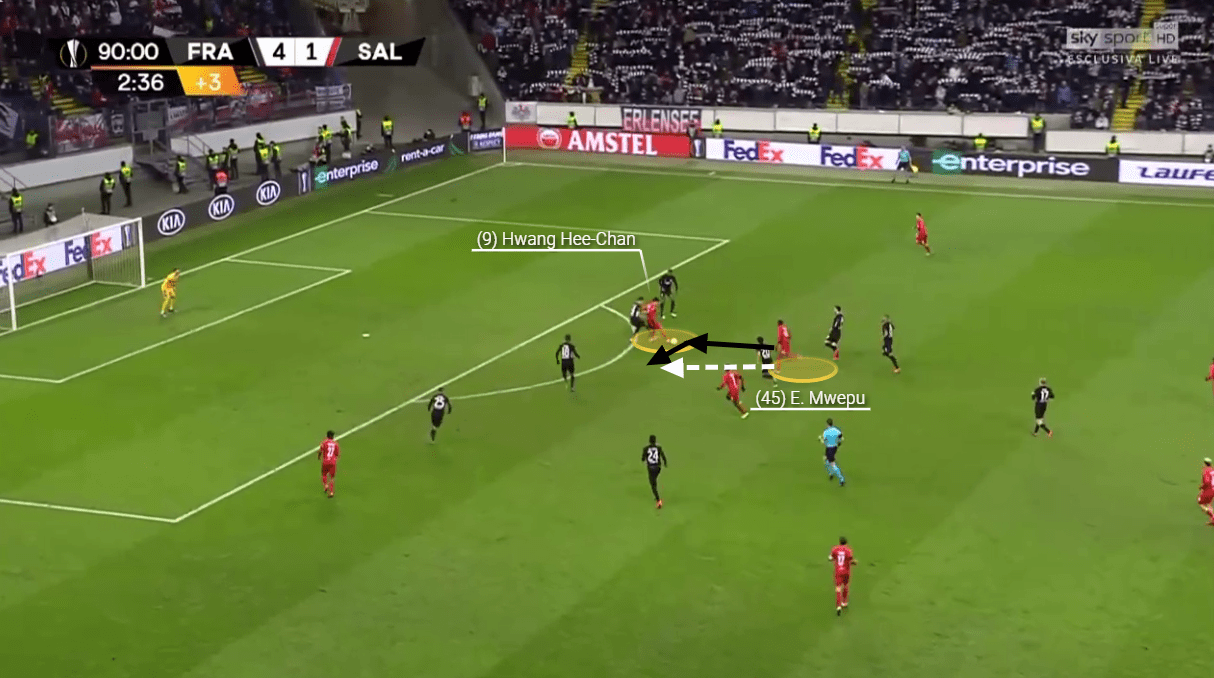
Here, Mwepu plays a pass to Hwang and continues his run. Hwang uses his body to hold off the Frankfurt defender and tries to lay off the ball back to Mwepu. He was fouled by the Frankfurt defender and Salzburg earned a freekick in a very dangerous position.
However, most of the time, he would initially be in line with the opposition defenders. When he realises there is a space in between the lines, he would drop to that space, play a one touch pass to his ball near teammate and make a daunting run forward.
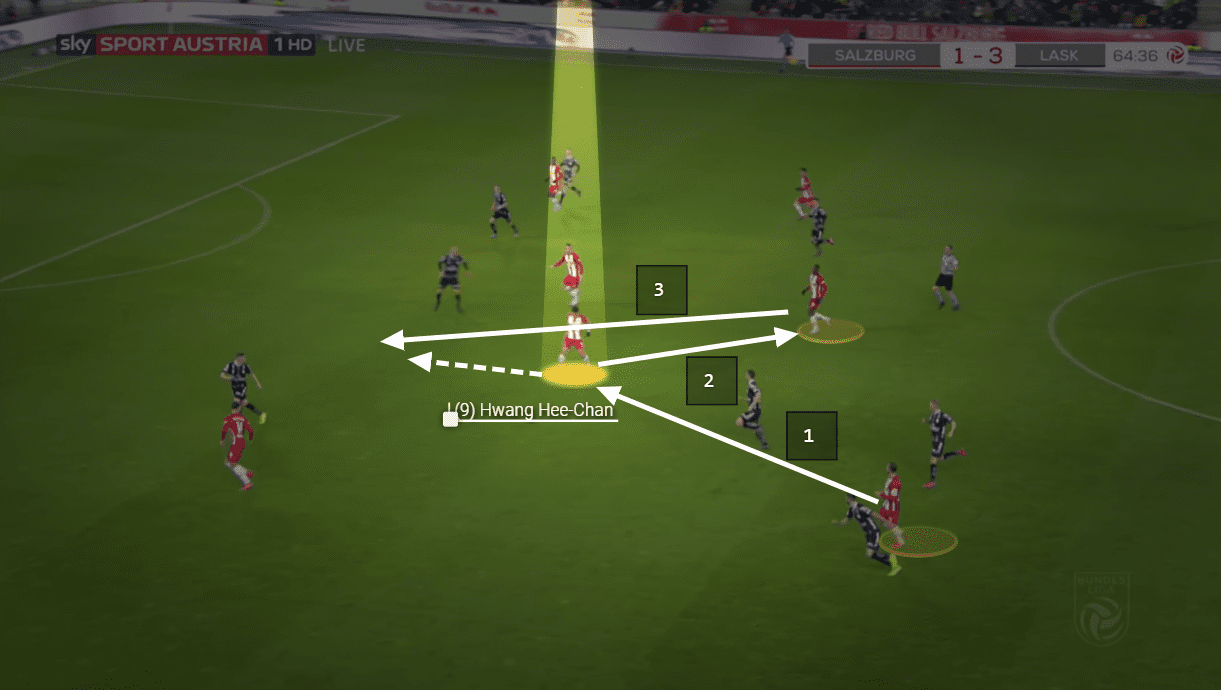
The other aspect of his dropping in between the lines is that it drags away a centre-back along with him which creates a space for his teammates to attack.
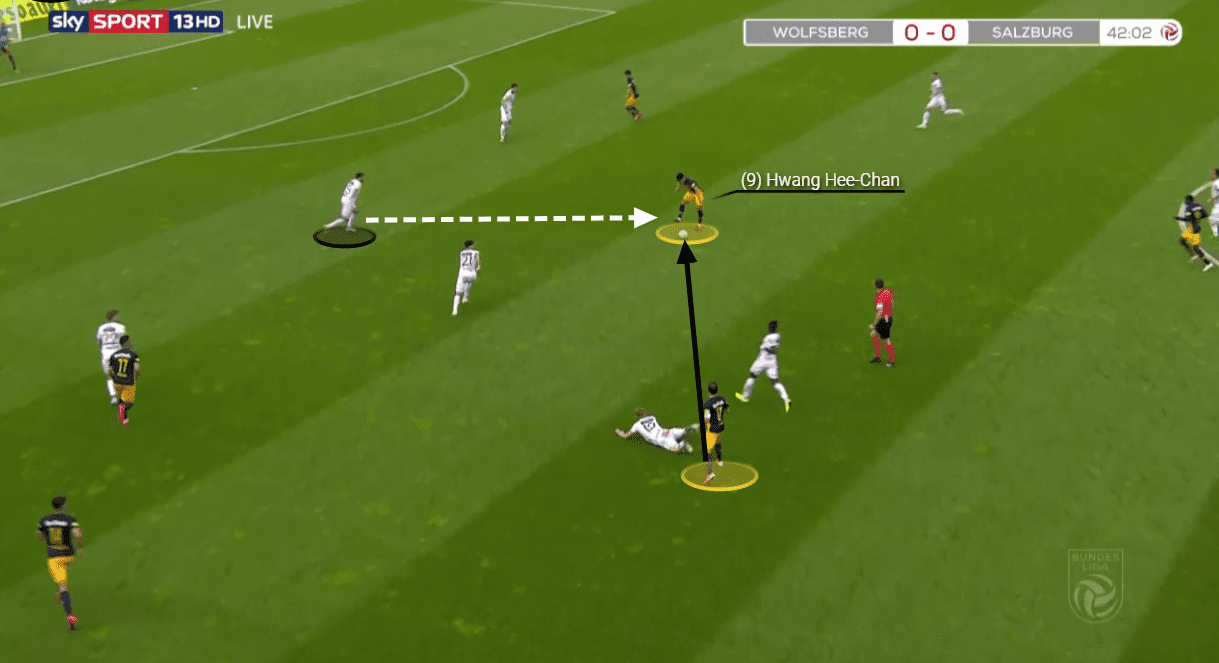
In this instance against Wolfsberger, he initially positions himself in line with the opposition’s last line of defence. Realising the space in between the lines, he drops to that space. He notices the opposition defender marking him was late in following him. So, he receives the ball in a diagonal position and attracts the defender towards him. As previously iterated, he is very intelligent in manipulating his body to gain the maximum advantage over the opposition.
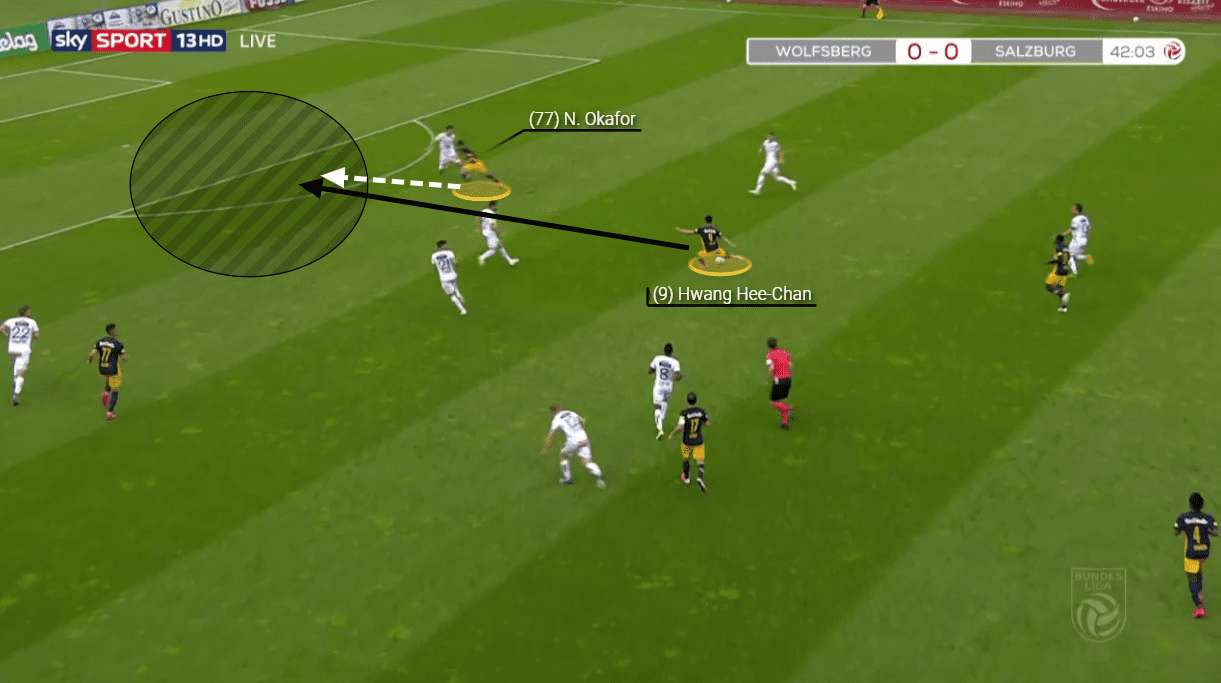
He takes another touch to attract the defender towards himself. Once the space is vacated by the defender, he plays a through ball to his strike partner, Noah Okafor.
Hwang Hee-chan is a great creator in these circumstances. His numbers reflect a massive signing for Leipzig. He has notched up 0.54 assists per 90, best for a striker who has played more than 500 minutes in the Bundesliga and Austrian Bundesliga combined. The South Korean is joint best in xA per 90, has recorded the most deep completions, ranks second in the most number of smart passes, only behind a player who has mostly played as an attacking midfielder than a striker and the magnificent stats just doesn’t end here. In every creative parameter, he ranks within the top three in both the leagues combined.
Jesse Marsch used Hwang in a more advanced role to bring out the best from the Bull, however, Nagelsmann used Werner in a deeper role, giving him the license to drop deep to open up a passing lane or position himself wide to run at the full-back owing to his brilliant dribbling skills.
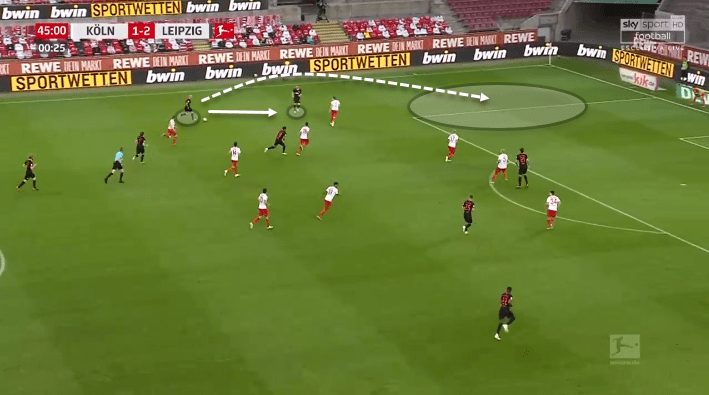
In this incident against Köln, he shifts to the left-flank leaving the half space for Christopher Nkunku to exploit whereas you would mostly find Hwang in the half space between the right-back and the centre-back. Once Werner shifts to the left, he either uses his dribbling skills or just looks for a passing option.
In the image below, you can see Werner dropping deep to open a passing lane for his goalkeeper. Werner, occasionally, is involved in this kind of action which you would hardly see in Hwang’s play under Marsch.

However, Hwang can be seen in such deep positions in counter-attacks, where he influences his team’s counter attack with his pace, acceleration, and dribbling ability.
The Firmino Role
Roberto Firmino is known for creating space for his teammates with his movement. We could say the same for the South Korean. He might not be as unselfish as the Liverpool custodian, but the South Korean often shows this aspect of his game with his intelligent movement.

In this scenario against Genk, he backtracks which forces the Genk defender following the South Korean backward. He does this to open up more space for the arriving Haaland to operate, who is already making a run to the vacated space and asks Maximilian Wöber to play the ball to the Norweigan.
In the screenshot below, against Hartberg, he sees Szoboszlai along with him have created an overload on the Hartberg right wing-back, Marcel Schantl.

He moves central and creates a bit of space for the Salzburg winger to receive the ball from the Salzburg right-back.

Once the Hungarian received the ball, he made a late run past the opposition right wing-back. His shot was saved by the Hartberg goalkeeper, but the rebound fell kindly to him to provide an assist for Daka.

Hwang is a versatile forward and another aspect of his game which can make him a world class striker, if not already, is his constant scanning of the ground as can be seen for the above goal.
Inside the 18-yard box, the unselfish movements decrease drastically but still the South Korean demonstrates such movements occasionally.
In this scenario below, he again tries to do a ‘ghosting’ movement against his opponent but to create space for Szboszlai.

In the image above, Hwang looks to execute the first step of ‘ghosting’ by moving in front of his opponent.

He then looks to go beyond him realising the space behind but observes the Hungarian arriving to the 18-yard box.

The South Korean completes the act of ‘ghosting’ but to free up space for the arriving Szoboszlai and it results in a goal for Salzburg from a Takumi Minamino cross.
A weakness to eliminate
The South Korean is brilliant when it comes to making intelligent runs behind the defence even when the ball is played long to him. His instant acceleration helps him to reach the ball faster than most of his opponents. However, one area which he may need to improve is his first touch when the ball is played long over his head. When the ball is played long to him, sometimes he may not get the opportunity and space for the ball to bounce in front of him and then pounce on the ball, rather he has to bring the ball down with his first touch and there comes the problem.

Against Hartberg, Salzburg wins the ball in the defensive third and Andreas Ulmer quickly releases the ball to the South Korean. Hwang beats his opposition defenders with his pace but fails to control the ball with his first touch.
In a more competitive league, these types of missed chances can make or break a team. Who knows if these sort of missed chances becomes the difference between Bayern Munich (or any other team) or Leipzig winning the Bundesliga next season?
Statistical Comparison
We have analysed almost all the aspects of Hwang’s game and have had a brief idea of how Hwang was utilised in Marsch’s system compared to Werner in Nagelsmann’s system.
Now, we would dive into the statistical aspects of both the players compared to other strikers who have played more than 500 minutes in both Bundesliga and Austrian Bundesliga.
Attacking metrics

As previously discussed, Werner has outperformed his xG by 0.28 whereas Hwang has underperformed his xG by 0.01. However, both of them rank very high compared to the other strikers. Hwang has scored more than 85.8 % of the strikers whereas Werner has scored more than 95% of the strikers.
Hwang likes to link up more in the advanced areas and take a lesser number of shots than Werner. However, Hwang shoots from a better position and thus records a massive 0.25 xG/shot. Both of them show almost similar statistical output in terms of dribbling and touches in box and approximately better than 95% of the strikers.
Passing metrics

Hwang edges over Werner in terms of assists provided, xA generated, and creative passes (consists of key passes, smarts passes and through balls). Rather, Hwang is the best in terms of assists provided per 90 and deep completions per 90. Second best in terms of smart passes per 90, key passes per 90 in both the leagues combined.
Hwang edges Werner in almost all the creative metrics. However, Werner’s willingness to drift in the wide areas can be vividly observed by the crosses attempted by the German.
Defensive metrics

Out of possession, Salzburg generally press with a two-man upfront whereas Leipzig mix their press with 4-2-3-1 and two-man upfront. However, one thing is common, both the teams press high to win back the ball as high as possible.
Both the striker’s defensive attributes are antagonistic to their offensive outputs. However, the data may be skewed due to the dataset that consists of players whose primary position may not be a striker but have played as a striker quite often.
Two things are vividly observed from this viz.. One – both the strikers don’t go for aerial duels, preferring the ball to be played to their feet. The German has attempted the least number of aerial duels per 90 in both the leagues and the win % could not be stated as impressive either.
Two – Hwang is much more aggressive to Werner, which can be understood by the increased number of defensive duels the South Korean indulges in and committing more number of fouls.
Is Hwang the out and out replacement of Werner?
Timo Werner and Hwang Hee-chan have been used in a bit different role for their respective teams. Werner likes to operate in between the lines and in wide areas whereas the South Korean loves to operate in the half spaces in line with the opposition defenders.
Nagelsmann has expressed his views about the ideal replacement to Goal.com. Going a bit further to what was mentioned in the introduction section, “It’s not possible [to replace him], you can’t clone a player. If Timo Werner leaves us, the main thing would be to replace 34 goals a season.” Nagelsmann stated, “That would be the main task, which perhaps could not be solved by just one player. It is important that we get the same output at the end of the day, that is the complex thing about the topic.”
The German coach may opt to alter his formation slightly to bring the best out of the South Korean or could go exactly the same with Hwang becoming the like for like replacement and Patrik Schick occupying an advanced position or could use Yussuf Poulsen or any other striker in a deeper role to the South Korean. In the last Bundesliga game against Augsburg, Werner was paired with Emil Forsberg up top where Werner played in a more advanced role. Nagelsmann may have wanted to observe the striker pairing next season if Hwang is played as an advanced/primary striker.
Even if he is used in the exact Werner role, we have seen Hwang is capable of producing killer passes and has the ability to link up well with the midfielders. Even from the wider areas, he has accumulated a few assists with his cutbacks and crosses.





Comments